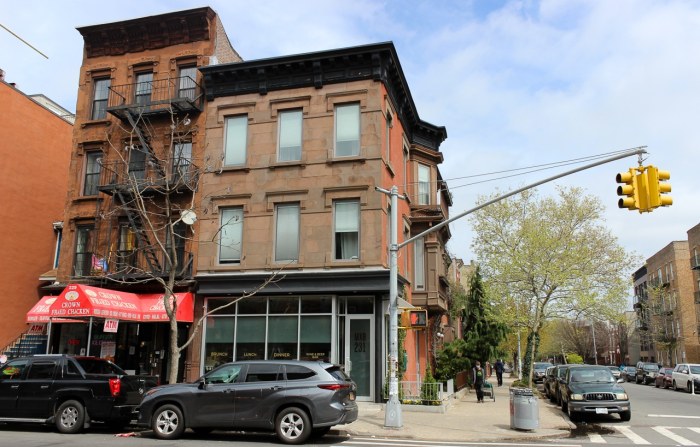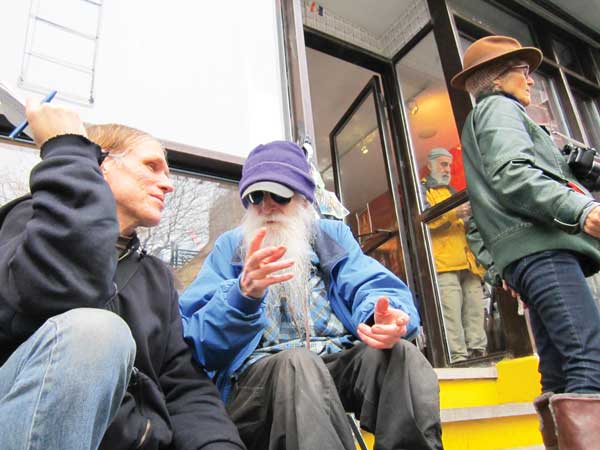
BY LINCOLN ANDERSON | In the center of Adam Purple’s magnificent Garden of Eden — amid its concentric circles of flowers, fruits, vegetables and trees — on Eldridge St. there was a double yin-yang symbol. In Chinese philosophy, yang represents light while yin represents darkness. …
Following The Villager’s recent exposés about Adam Purple’s stunning history of sexually abusing his own daughters and stepdaughters, the newspaper asked community activists for their reaction to the revelations. Not surprisingly, the responses ran the gamut from anger and denial to support and praise for the paper’s bringing the disturbing story to light.
Adam Purple, real name David Lloyd Wilkie, died in September at age 84 while biking over the Williamsburg Bridge. Following The Villager’s breaking the news of the legendary gardener’s death, his two daughters came forward to share their experiences of growing up in a sexually abusive household and of Wilkie’s serving up to two years in prison in Australia for child molestation.
Subsequently, his two former stepdaughters also told The Villager their stories — with the older one, Dorothy, revealing that Wilkie sexually abused her nightly for years and finally raped her when she was 12, for which he was arrested and went to jail. Meanwhile, his youngest biological daughter, Lenore, provided details on what her older sister, Jenean, meant when she had said, “We were trained to perform.” Namely, Wilkie regularly made the young girls put on naked shows, simulating adult sexual acts, in front of adults at parties.
These revelations and more were reported in two Villager articles, “The dark side of Purple” and “All Purple’s daughters.”
After his release from prison in Australia, Wilkie was reportedly deported, apparently to California, soon afterward making his way to Forsyth St. on New York City’s Lower East Side. There, he re-emerged as Adam Purple, a psychedelic hippie gardener bedecked in purple tie-dye with a long, flowing white beard and ideas about environmentalism and sustainability that were ahead of his time. He created the Garden of Eden on five city lots, but it was ultimately razed in 1986 for an affordable housing project. Thirteen years later, the city forced him out of his building, which had been abandoned by the landlord at least 25 years earlier.
In his last couple of years, Purple lived in a small room at Time’s Up, the environmental and cycling group, in Williamsburg. He had long ago renounced the internal combustion engine and famously biked everywhere. He felt energized being around the young cycling activists. He would help out and sort parts at their free bicycle-repair workshops.
‘A lot of disrespect’
When asked by The Villager for his thoughts about the two articles on Purple, Bill di Paola, the executive director of Time’s Up, said, “I have no comment — just a lot of disrespect for you. When are they going to stop?” he said of the articles. “It seems pretty negative, the whole thing. Time’s Up runs 100 percent positive events all the time,” he added.
As for, Chris Flash, editor of The Shadow, the East Village anarchist newspaper, he said Purple’s legacy, at least during his time on the Lower East Side, was all positive.
“The allegations about David Wilkie do not change my view of Adam Purple at all,” Flash said. “The Adam Purple I knew has nothing to do with the David Wilkie who is being accused of committing horrible and inexcusable acts 50 years ago. The Adam Purple I knew was a visionary, who, for the past 44-or-so years, was a valued and highly regarded member of our community, contributing his wonderful garden, his insights and his intelligence. No one has come forward during that time — or, as The Villager would seem to prefer, after his death — to allege that Adam Purple acted improperly with anyone here, sexually or otherwise.”
‘A patriarchal misogynist’
However, in an e-mailed response, Fran Luck, a longtime activist on the left who produces “The Joy of Resistance,” a multicultural feminist radio show on WBAI, called The Villager’s articles on Purple horrifying. She said they show him as the patriarchal misogynist he truly was.
“Your front-page photo of the Willkie ‘family’ — featuring four uncomfortable-looking girls trying to smile for the camera — is horrifying and heartbreaking with the hindsight of knowing they were all being molested by their father at the time,” she said. “Not just molested but trained with fanatical zeal (i.e.: the ‘dildo’ training) to fulfill their ‘purpose on earth’ — which was to ‘please men.’ This is the patriarchal and misogynist vision of the ‘visionary’ Adam Purple.
“And he was not alone in his beliefs and actions,” Luck added. “During the ’60s, there were many cults in which a patriarch dispensed sexual favors through the women he controlled — much as Adam used his daughters as ‘spectacle’ and ‘pleasurers’ for his orgy gatherings.
“Purple left a huge amount of emotional wreckage, but never ‘got it’ — he was still proposing threesomes to his adult daughters, well into his garden period. In the ’60s we used to say: ‘You are either part of the solution or part of the problem.’ Those who think this is all made-up or trivial — a small stain on a great man’s reputation — are part of the problem.”
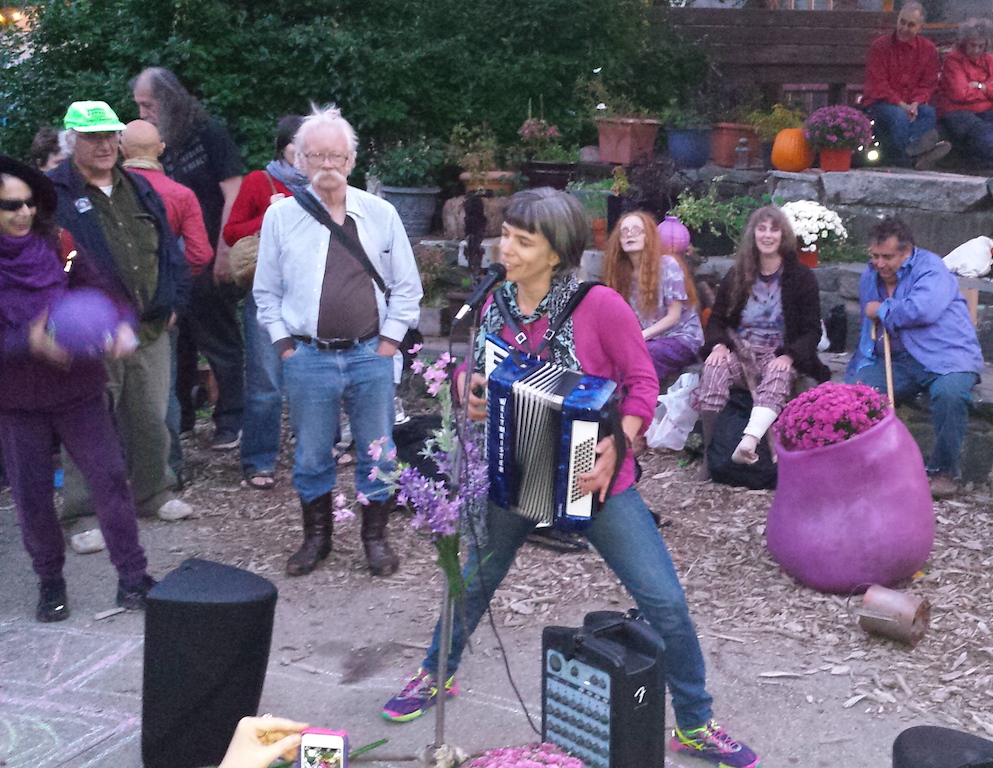
‘Nonsexual’ as senior
Meanwhile, two local gardeners said the bombshell reports, in fact, have turned Purple’s reputation among neighborhood green thumbs into, well, mud. Both requested anonymity, saying they were recently “attacked” at a meeting for being friends with the gardens godfather.
One of them, who was friends with Purple during his last 20 years, said he never observed any evidence of his being a sexual predator.
“I never saw the guy with a hard-on,” he said. “He was a nonsexual being when I knew him, so it was a very deep shock. I only saw him maybe hug a middle-aged woman or kiss a woman’s hand. It was a total shock and letdown,” he said of the revelations.
“But now they’re saying Thomas Jefferson was a serial rapist,” he added. “All these people that are doing extremely good things may have something on the other side.”
At the same time, he said, “I don’t see how they can change what he did in New York City here.”
Plus, Purple deserves a chance for forgiveness, in his view.
“Malcolm X was doing very bad things as a young guy but later became a family man and a religious leader,” he said. “It’s like Jean Valjean in ‘Les Miserables’: Just because he stole some bread because his kids were starving, that inspector guy was going to bring him in and ruin his life.”
But, to hear him tell it, many gardeners apparently aren’t seeing it that way.
“We can’t have pictures of Purple prominent anymore,” he said. “People are tearing them down and throwing them away. They’re sanitizing the whole thing of Purple. That’s it — he’s history.”
Gardeners are now busy focusing on “Gardens Rising” — a $2 million state-funded initiative to install rainwater-capture systems and other projects to mitigate storm runoff in the more than 40 community gardens in the East Village and Lower East Side. The shocking Purple articles are only a distraction to this effort, he said.
“No one wants to talk about Purple anymore,” the man said.
‘Can’t forgive him’
His friend, however, disagreed that Purple’s legacy on the Lower East Side should remain unchanged in light of his criminal past as a child molester.
“I’m sorry, as a woman I can’t forgive what he did,” she said. “What he did was horrific to any child.
“I also like the fact that you put in that the mother abused her daughter,” she said of The Villager’s reporting that Diane, the youngest daughter of Romola, Wilkie’s wife in Australia, said Romola actually sexually abused her.
“Her first rule was to protect the girls,” the female gardener said. Along with Diane, both of Wilkie’s own daughters say that Romola was complicit in the sexual abuse, though Dorothy, Romola’s oldest daughter, strongly denies this.
(In an interesting random Purple fact, the male gardener noted that Wilkie was baptized a Mormon.)
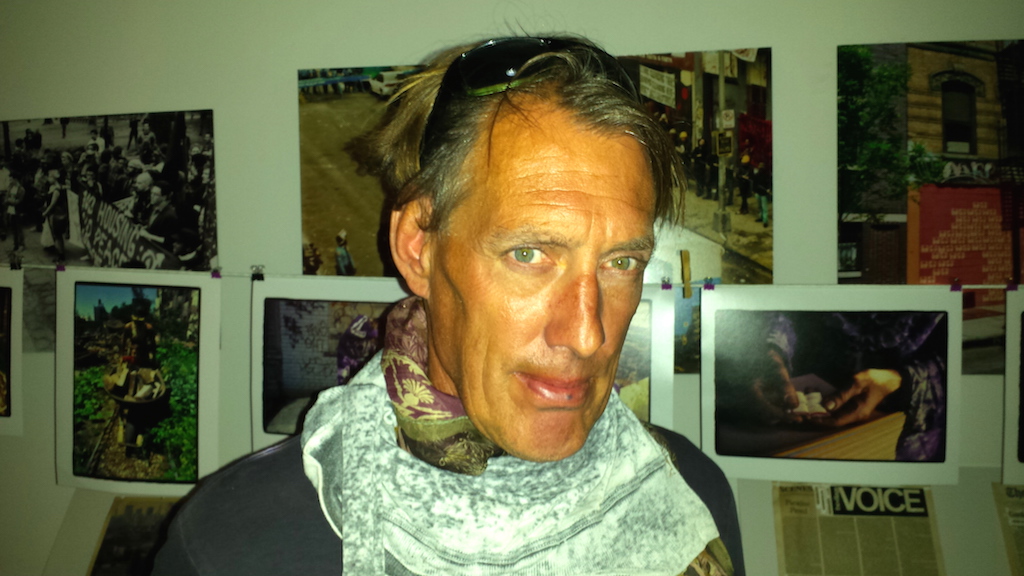
Another Adam Purple stalwart is George Bliss, who, in the 1980s, to raise awareness about the embattled garden, laid down 40 miles of purple footprints around the city leading back to the Eldridge St. green oasis.
Like others interviewed for this article, Bliss said he had not previously known of Purple’s conviction for child molestation. However, both he and the above unnamed male gardener said they knew Purple had been in Australia.
In light of the new information, Bliss said, “I think we all think that some of his activities in New York were to make up for what he’d done.
“I knew him in ’85 / ’86. I didn’t see any evidence of that. His son [Adam David] was there, he was around age 10. I think he was reformed,” he said of Purple.
“All I knew was that he lived in Australia,” Bliss recalled. “I thought it was because of the threat of nuclear war. A lot of people were living there in that context. Mind you, when I was hanging around with Adam, we weren’t jabbering about Australia — we were focused on saving the garden.”
‘Garden mattered most’
More to the point, Bliss said, as far as he is concerned, Purple’s visionary ideas trump his history as a sexual predator.
“Look, I also think very highly of Buckminster Fuller — the Dymaxion car, the geodesic dome,” he said. “If I had found out a month ago that he was a child molester or he murdered somebody, would it matter? Not at all. The main thing is the geodesic dome. The same thing could be said of Einstein and his theories of matter and relativity.”
Similarly, Bliss said, “To me, what mattered most was the garden. And the next phase would have been housing underground — as he knew, it’s 50 degrees 10 feet down all year. It’s naturally insulated. You don’t have to burn fossil fuels to heat it.”
Bliss was referring to a plan Purple drew up to create a ring of underground abodes around the Garden of Eden.
He said the uncompromising green legend showed him a rendering of his idea: homes mostly buried in the earth with sloping green roofs — akin to the Hobbit houses of J.R.R. Tolkien’s mythical Middle-earth.
‘Survival matters most’
“I just don’t see a lot of bright lights out there to prepare us for what’s coming,” Bliss said of the world’s dire environmental challenges. “To me, what matters are these ideas. Our survival on this planet is what matters. It’s not like I took the button for the garden off my sweater [after reading The Villager articles]. Look, the population is going to double in the next two generations. It’s doubled since 1972; since I graduated high school, since he started the garden, the population has doubled.
“He described a way of living that creates a utopia,” Bliss continued about Purple. “There is nobody like that who is that radical in their thinking. He said, ‘Do it together, without government, no land ownership, live together, with nature — boom.’ It’s as simple as can be — get off the grid. The idea of living in that much harmony with the earth: I agree that that is how we have to proceed. We have only so many great ideas that can save us — and this was one of them.”
‘A creative genius’
With his Garden of Eden, Purple “was like an artist, a creative genius,” Bliss said. “And, of course, it was theater. At some point, he decided to turn himself into this artist — and at a certain point, he thought the garden was too beautiful to destroy.
“I can only hope that some of Adam’s ideas live on, can be incorporated into housing projects, lifestyle projects,” Bliss said. “He could have done more, but we were not ready. There were not people ready to live without polluting, to try to rediscover the human niche in nature.”
Monument crumbling?
Nevertheless, he admitted, regarding the news of Purple’s criminal past, “I’m very upset to hear about it. I’m glad we’ve had a month or two to think about it. I’m not going to be pushing for a plaque for him now after that controversy. Or could we get a statue of him in Central Park — but I don’t think that could happen. So I’m not going to put my time on that.”
Purple was also well known in Central Park, foraying there daily from the Lower East Side on his bike to scoop up fresh horse manure to fertilize the soil in the Garden of Eden.
As for Bliss himself, he said, “Now I’m really interested in seasteading. It’s completely autonomous, but also completely free of government influence.”
Seasteading is the idea of living on a floating community in international waters.
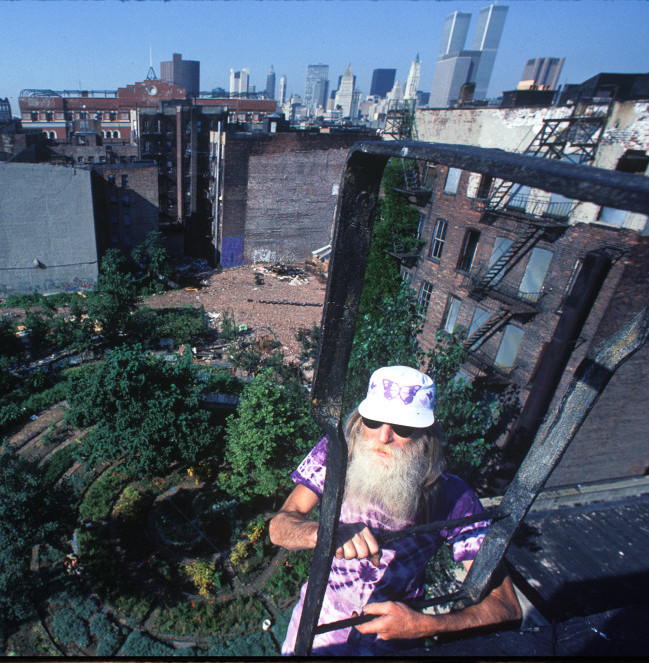
‘He was psychotic’
Former Councilmember Margarita Lopez, however, who fought to clear the Garden of Eden for housing, said she never saw Purple as a hero — but rather as a psycho.
“I was like, ‘Wow!’” she said of her response to reading The Villager’s recent coverage of him. “But, in honesty, I was not surprised, because when I interacted with him, I believed he was completely psychotic in those years.”
However, she was quick to add, “But not that psychosis and pedophilia necessarily go together. I believe he was mentally ill. Also, his behavior was always so strange when it came to women. … He was a machista,” she said, using the Spanish word for “male chauvinist.”
Lopez first met Purple in 1978 when she was working for Action for Progress, a local housing group. Purple by then had completed only about half of the Garden of Eden, she said. Lopez would go on to become president of the Lower East Side Joint Planning Council, an umbrella organization of 43 local organizations that was focused on developing affordable housing in the neighborhood.
According to Lopez, before Purple had even arrived on the scene, local housing groups had already put together a plan for the Eldridge St. site for affordable housing.
“We cut a deal with Koch,” she recalled. “People gradually started moving out of the buildings and were relocated. It was going to be called Esperanza. When Adam went and built the garden in there, he was told that he could not do that. And from that moment on, we were confronting each other because he kept building his garden.”
Was alien to her
She vividly remembers her first conversation with Purple.
“He told me he was Adam and he came from a planet, Urana…something, and that this was the Garden of Eden and his wife was Eve,” she said. “He believed that he was the first man and she was the first woman. And then he’s going on that this garden coincides with some lines and the planets — that this garden is the center of the planet and the direct connection to the planet Uranu… . He has a mathematical equation for that he put together — it was the exact mileage from point ‘A’ to point ‘B.’ It was a very convoluted story.
“It was impossible to communicate or make sense because he had this idea where this particular piece of land was connected with that planet. I said, ‘This man is crazy.’”
Lopez met Eve. Then, a few years later, she met a second Eve.
“I said, ‘Wait a minute, this is not Eve, this is somebody else,’ ” Lopez recalled telling him. “ ‘You telling me there is a second Eve now?’ And he got very upset and he walked away. … And I met his son also.”
At one point, as reported by The Villager back in the ’80s, Purple declared he would block the bulldozers with his body if the city tried to raze his garden, to which a furious Lopez responded she would tear the garden down with her own bare hands.
‘Site was designated’
“Absolutely, I remember that,” Lopez said. “I remember saying that this has to stop, that this garden cannot stay here. He was impairing hundreds of units of housing. It was very important to bring back people who were entitled to live there. When he did this, he knew very well this site was designated — the plan to build housing there preceded me.”
Yet, Lopez said, she also worked hard to build and protect other gardens in the community.
“I believed that it was very important to have gardens and open spaces in the Lower East Side. The greening of the Lower East Side was critical to reduce the impact of Con Edison,” she said, referring to the utility company’s E. 14th St. power plant. “People need to live in a place where green exists. I believe we were doing something that was into the future. But his garden came in violation of the agreement with the community.”
Lopez noted she fought off a plan by the Lower Eastside Girls Club to build their clubhouse on La Plaza Cultural garden, at E. Ninth St. and Avenue C — “I said, ‘No, that is a space for people to perform and do their art,’” she recalled — and another plan by Lower East Side People’s Mutual Housing to develop the 9th St. Community Garden, located kitty-corner from La Plaza.
‘Did a lot of damage’
“He did a lot of damage to our community,” Lopez reflected of Purple. “The biggest damage he did was to continue building that garden in that site that was set aside for housing. And, particularly, he harmed the relationship between the people who wanted to build housing and the gardeners.”
Lopez said housing activists were simultaneously fighting another project — former Mayor Ed Koch’s plan for artists’ housing (which they felt was too exclusive, as opposed to general affordable housing) on E. Eighth and Eldridge Sts. This spread their energies thin, preventing them from fully focusing earlier on ousting Purple from the garden.
“Somehow, he was able to get in contact with some famous people, some people in power,” she recalled of how support grew for the Garden of Eden from the likes of poet Allen Ginsberg and architect James Polshek, among others. “Suddenly, he became some sort of glorified hero. He was no hero. He was a human being. He had ideas that were affected by being psychotic. A lot of people in this community knew that he was mentally ill. A lot of people chose to ignore it.
“The fact that he may have suffered from mental illness doesn’t make him a bad person,” Lopez added. “But that whole issue of that garden was tainted and surrounded by his psychosis.”
‘That’s a sociopath’
Regarding the story of Purple’s history of sexual abuse of his own stepdaughters and daughters, Lopez said The Villager was right to bring it out into the open.
“When I learned that he molested his daughters, I said, ‘Oh, my God,’” she said. “That’s a sociopath — people that would harm people without blinking their eyes. It’s important to say that these behaviors have nothing to do with mental illness. It’s the inability to get outside of yourself: You are the center of the planet,” she said of the abusers’ twisted mindset.
‘You’re doing a great thing’
Some commenters, though, have disapprovingly likened The Villager to the National Enquirer for divulging Purple’s perverted past and describing how he sexually abused the four young girls in his blended family.
“I disagree,” Lopez said. “Actually, The Villager has been a great asset in this community and it’s reporting is objective. And this issue of sexual abuse of children needs to be put on the front page of every newspaper and in the media, to say, ‘We are not in the Middle Ages.’”
To cover up information like this would be “really horrible,” she said.
“You’re doing a great thing by publishing this article,” Lopez told the newspaper. “What you’re doing is fair and right. You know all those reporters who did that with the Catholic Church — you are doing exactly the same thing.
“As long as we pretend that doesn’t happen or isn’t there, or people are lying, that problem will continue. This is very important because the victims need to heal — and the only way they can heal is when this is acknowledged.
“God bless those girls, and God bless you for doing this article,” Lopez said. “Don’t back off. The issues of bicycling, gardening — that had nothing to do with his actions. It’s time to decide, when somebody abuses another person sexually, it needs to be denounced.”
No sympathy
Valerio Orselli was an ally of Lopez’s on the Lower East Side Joint Planning Council, fighting to raze the Garden of Eden.
“Pedophiles need to be exposed, whether they be priests, educators or seemingly harmless eccentrics,” he said. “Sad to say, Adam escaped any punishment because the revelations in your story came long after the fact and, as often is the case, after he was dead. So many lives damaged or destroyed.”
Rejected compromises
On the subject of the garden, he said, “Actually, Adam played a significant role in the garden’s demise. We tried to work out a compromise with him; we proposed setting up a nonprofit to administer the garden, preserve the core area and still build the housing. Adam refused to give up any control and the housing was built, with no garden.
“There is a simple reality about gardens versus housing,” Orselli added. “Due to the cost of new construction, the only sites that are viable in New York City — and particularly Manhattan — for low-income housing are on city-owned land. Housing has to be the first priority since people can’t live in gardens — not even the Garden of Eden. Where housing advocates and gardeners can work together in the spirit of compromise, both housing and gardens frequently can be accommodated; witness the Liz Chrystie Garden on Houston St. Where compromise is not possible and the proposed housing is more than a token amount, the housing must prevail.”
What would Hegel say?
East Village journalist Bill Weinberg offered that the story of Adam Purple’s disturbing past offers a lesson to be learned about putting people on pedestals.
“No, The Villager was not wrong to bring it to light,” he said. “If the daughters chose to go public, their wishes should be respected. Let this be an inoculation against ‘heroes.’ Every human being has the capacity for evil. Maybe it even says something about Hegel’s paradoxical unity of opposites that the same man who created something so beautiful on Eldridge St. apparently had such a dark side.”
Freedom from slavery
Finally, many have wondered if Purple ever saw the video by his daughter Jenean that — without mentioning him by name — recounted her growing up as a self-described “sex slave” and how she struggled for decades afterward to recover from what she called her childhood “brainwashing.” Two days after Jenean posted on YouTube the video of her performance, done at an improv theater in the Northwest, Purple suddenly died.
However, Jenean last week told The Villager that the performance was all about her own healing, and that Purple was irrelevant. There is no evidence that Purple ever saw the video.
“I told him nothing of the ‘Coming Out’ piece,” she said. “It was a spontaneous creation. I would not have thought to clue him in. The piece wasn’t about him or the abuse. It was a way to celebrate finding my way from slavery to authenticity. None of his business.”
















